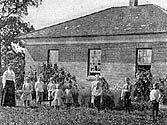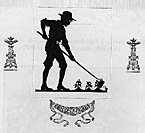Introduction
Planting the Seeds
Cultivating the Garden
Second-Generation Gardening
Landscape Architecture
Railway Station Gardening
Gardening in the Schools
The Cultivators
Reaping the Harvest
Bibliography
Photos by Beth Powning
Other Gardening Sites
Acknowledgements |
Cultivating the Garden
Gardening in the Schools
James Wilson Robertson, an early educational reformer, believed that rural life could be improved by making practical knowledge more available on a local basis and by changing education to make farming more attractive to children and qualifying them to be successful at it. His view was shared by Sir William Macdonald, a Montreal tobacco merchant and philanthropist. Their campaign, usually referred to as the Macdonald movement, got underway with the new century. School gardening was among the most successful of the practical elements it encouraged.
Teachers were sent to take special courses and gardens were planted and tended in many communities - at home as well as at school. The movement culminated with what were known as Consolidated Schools, financed by Macdonald, in Ontario and the Maritime Provinces. Here each pupil tended his or her own garden. The idea spread westward, but the costs of funding such schools proved to be impossible to maintain.
| "In 1906, in Carleton County, in schools without gardens 49 per cent of the candidates passed, while those who came from the five schools to which were attached gardens 71 per cent were successful. Apparently the work with the hands in the garden increased the capacity for work with books." |
 |
Sherwood, Herbert Francis.
Children of the Land: The Story of the Macdonald Movement in Canada.
New York: The Outlook, 1910, p. 900. |
"We are convinced that garden work assists largely in forming the foundation for a firm will and self-reliant action, or, in other words, for moral character." |
Rittenhouse School and Gardens: Jordan Harbour, Lincoln County, Ontario.
Compiled by Harvey Goymer.
Toronto: Briggs, 1911, p. 51. |
| A pamphlet supplied to Ontario classes to encourage gardening and record keeping. "Keeping a Garden Journal will help you to become a good gardener as well as a good scholar." |
 |
Department of Education.
Children's Gardening.
Toronto: L.K. Cameron, King's Printer, 1912, p. 4. |
|
 |
Magnan, Jean-Charles.
L'Agriculture à l'école primaire.
Saint-Casimir, Québec: [s.n.], 1925. |
| "Even before the Great War started, in the predominantly rural province of Alberta great emphasis was placed on school gardens. Early annual reports abound in pictures of such activities showing sad-faced little boys and girls hoeing and raking and weeding their vegetable and flower plots under the grim supervision of their teachers. Time after time the inspectors report on the growing success of the school garden programme, although not all comments are laudatory, as for example this from Inspector M. E. LaZerte: ‘There are too many cases where the little mound of earth serves to mark the grave of the seed or of the early-departed plant.' " |
Chalmers, John W.
Schools of the Foothills Province: The Story of Public Education in Alberta.
Toronto: University of Toronto, 1967, p. 51. |
|
